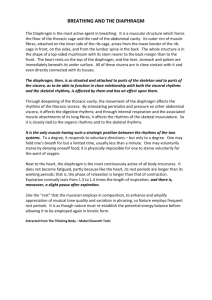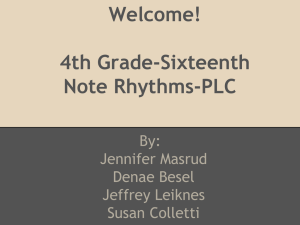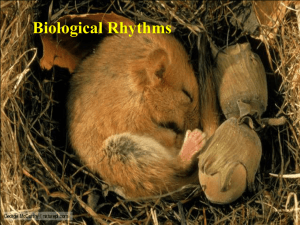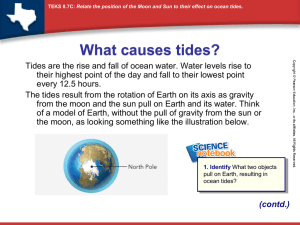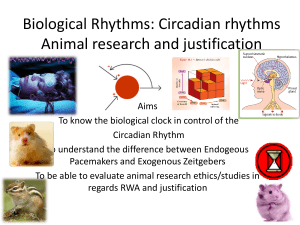Biological Rhythms slides 1
advertisement
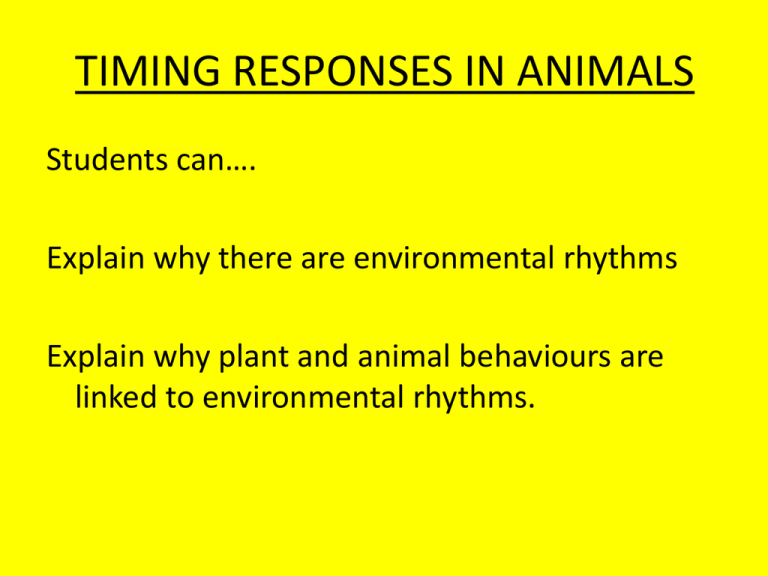
TIMING RESPONSES IN ANIMALS Students can…. Explain why there are environmental rhythms Explain why plant and animal behaviours are linked to environmental rhythms. Earth’s Rhythms • Yearly orbit of Earth about the sun, together with the tilt of its axis, cause the seasons • Seasonal contrast increases with increasing latitude (ie. least contrast is near the equator) • Seasons have characteristic abiotic conditions (temp, day length, rainfall etc) Daily Rhythms, 24 hr • Caused by daily rotation of Earth on its axis • Produces alternating light and dark periods • Length of day depends on latitude and season • Sun also affects daily rhythms in temp, humidity, wind Effects of the moon • Moon orbits the earth once per 27.3 days • Affects the tides: moon’s gravitational pull combined with Earth’s rotation • Twice-daily ocean tides • Tidal levels vary during moon’s phases (spring and neap tides) • Changes in illumination (light) at night Environmental Rhythms and Animal Behaviour • Most daily and annual animal rhythms are linked to cyclical environmental changes caused by Earth’s rhythms • Includes periods of activity & sleep, feeding & drinking, breeding, migrations, fluctuations in body temp, sensitivity, hormone levels What are the biological advantages to an animal species of synchronising its activities to Earth’s rhythms?? • Better food supply • Avoiding predators • Avoiding competitors • Finding more favourable environmental cond’ns • Avoiding harsh conditions • Finding mates or a breeding place • Raising young successfully ***ENHANCED SURVIVAL & REPRODUCTION*** Biological Rhythms • Animals and plants exhibit all kinds of regularly repeated behaviours • eg. activity patterns, reproduction, migration, hibernation • EXOGENOUS rhythm: A direct response to environmental cues (external) • ENDOGENOUS rhythm: Internally controlled, will continue in absence of environmental cues (involves a biological clock) HOMEWORK • BIOZONE Pg 187 and 188 questions BIOLOGICAL RHYTHMS (biozone 188) LEARNING OUTCOMES • Explain what BIOLOGICAL RHYTHMS are • Explain the ADVANTAGE of these rhythms • Explain what a BIOLOGICAL CLOCK is What is the advantage of having a biological clock? • • • • Activity remains in sync with environment Keeps sleep/wake cycles constant Able to predict events (eg. winter, spring) Synchronise breeding stages with others of your species and the seasons • Plants: flowers when the bees are out, lose leaves in winter when cold BIOLOGICAL RHYTHMS • Animals and plants exhibit all kinds of regularly repeated behaviours • eg. activity patterns, reproduction, migration, hibernation • EXOGENOUS rhythm: A direct response to environmental cues (external) • ENDOGENOUS rhythm: Internally controlled, will continue in absence of environmental cues (involves a biological clock) Remaining in sync with environment • Biological clocks must be reset at regular intervals • This is the purpose of the ZEITGEBER or external timekeeper • This is the environmental cue that resets the biol clock • ENTRAINMENT is the process of resetting the biol clock BIOZONE activities • Pg 189-190 The Human Biological Clock • Runs at about a 25.5 hr day • But we need it to be synchronised with our environment (a 24hr cycle) • Mammals including humans have a master circadian clock in our brain • Two tiny groups of cells called the suprachiasmatic nuclei (SCN) in hypothalamus • Located behind our eyes, 1/3mm in size What’s involved? • Eyes • SCN • Hypothalamus • Pineal gland • Melatonin hormone Light stimulus Darkness stimulus SCN Shuts off melatonin production AWAKE Pineal Gland In Hypothalamus Melatonin production PROMOTES SLEEP Zeitgeber = external timekeeper • The light/dark cycle acts as the ZEITGEBER to reset our internal clock to a 24hr cycle • Resetting of the clock is called ENTRAINMENT • By following the day/night cycle, animals can better exploit the seasonal changes in the environment The Importance of Melatonin • Is the hormone controlling our sleep/wake cycle • When produced at night it promotes sleep • May help in the timing of onset of reproductive cycles in many species of animals • Enhances the immune system • More is produced over 24 hrs in the short days of winter than in summer (sleepier in winter?) Today: Circa- rhythms & Actograms • Learn how to read and interpret Actograms • Weta as an example Lots of human daily rhythms • • • • • • BIOZONE “Human Biorhythms” Susceptibility to alcohol Body temperature Blood pressure Cell divisions in skin Time of labour onset What are Actograms? • An actogram is a special graph • Shows the activity of an animal or plant during the day/night and over many successive days. • Gives a good picture of when the organism is active at any time. • Can use them to monitor changes over time under constant conditions Actograms show us: • Light/dark regime in lab conditions • Period = length of one full cycle eg. From start of activity to the next start of activity. • The Free-running Period = how long the cycle runs in the absence of all environmental cues • Phase-shift = New start time for the activity (eg. 8am start changes to 10am) How much has it shifted? 2 hours later DAILY RHYTHMS • Daily night/day cycle of about 24 hours • Three types of activity are seen in animals: 1. Diurnal – mostly active during the day Eg. Humans, honey bees, tui 2. Nocturnal – mostly active at night Eg. Kiwi, owls, bats, moths, kakapo 3. Crepuscular – most active at dawn and dusk eg. Rabbits, mosquitos, wombats Today: Types of Biorhythms • Explain what is meant by circannual, circalunar, semi-lunar, circatidal and compound rhythms • Give examples of each of the above rhythms Environmental rhythms vs. Circa- rhythms • Environmental rhythms are daily, annual, tidal, lunar etc • Animal rhythms can only be called circadian, circannual etc if they persist under constant conditions in the lab. Cycle length Cues • Circadian (about 24 hours) • Light/dark cycle • circatidal (about 12.5 hours) • Incoming/outgoing tide • Moon phases • circalunar (about 29.5 days) • circasemilunar (about 15 days) • Moon phases / spring high tides • circannual (about 365 days) • Day/night length (not temperature, too variable) NZ Example of a Circatidal Rhythm • Chione stutchburyi cockle • exhibits clear endogenous circatidal rhythmicity in shell gaping and siphon extension and also in adductor activity • occurred at the times of expected high tides Advantage of the cockle’s endogenous rhythm being in time with high tides? * avoid dessication at low tide * increased feeding time * increased survival Circatidal example • Fiddler crabs forage during low tide • If taken away from the shore, the circatidal activity can persist for 5 weeks Tidal/lunar cycle animation Remember: the position of the sun and moon generate our tidal patterns each month Circalunar rhythm example • Young salmon migrate downstream • Soon they will migrate to the sea • At new moon, surge in output of hormone thyroxine • Brings about changes in physiology to cope with being in salty water Circalunar example • Marine worms called Palolo worm • Spawning (egg laying and sperm releasing) is synchronised by the moon • Advantage? Males and females will spawn at the same time = increased reproduction Example of Semi-lunar rhythm • Californian grunion • Leaves the sea to deposit its eggs (spawning) in the sand of several beaches, Feb-Sept • Spawning only takes place on 3-4 nights after full or new moon (when tides are highest). • Eggs buried in sand to develop, will be washed out again during next spring tide in 12 days Advantages of spawning at spring tide? • Eggs deposited high on the sand by high tide so won’t be washed away • spawning bed is not disturbed by the tides until the next spring tide cycle • The eggs have a safe refuge buried in moist sand in which to develop. • Increased survival and reproduction NZ Inanga: Galaxias maculatus • Adult life is spent in lowland streams and rivers • During spring high tides, ripe adults move up on to the grassy flats of river estuaries, go to areas covered by water only at the spring tides • The eggs develop and usually hatch at the next spring tides that cover the grasses • Advantage = reproduction and survival • The manner in which the fish are able to perceive and respond to the lunar cycle remains a complete mystery. Annual Rhythms eg. Reproduction, migration, hibernation • • • • Eg. Long-tailed Bat in NZ Hibernates 4-5 months over autumn/winter Reproduces annually in summer months Responding to day/night length Advantages for the bats? • Breeds at the warmest time of year • More food around during breeding season • Avoids the cold months Compound Rhythms • Animal responds to more than one environmental rhythm • Eg. Sandhopper – uses lunar orientation at night, solar navigation during the day. Palola marine worm • Highly synchronised breeding • Research shows this is related to not only the moon’s phases, but also solar, daily and tidal rhythms. PLANT TIMING RESPONSES • Some plants exhibit rhythmic activity • DAILY RHYTHMS: eg. Opening/closing of some flowers such as night-scented jasmine • Eg. Leaf movements – the prayer plant leaves move to an erect position at night, horizontal during the day. Plant rhythms…. ANNUAL RHYTHMS: • Eg. Production of flowers, loss of leaves in autumn, germination of seeds • Usually in response to change in light/dark hours WHAT’S THE PURPOSE? • Plants synchronise with animal activity – Eg. Open flowers and secrete nectar when animal pollinators are active in daytime – Production of flowers coincides with the life cycles and activity of animal pollinators PHOTOPERIODISM AND FLOWERING • PHOTOPERIODISM: the regulation of activity by the length of daylight (the photoperiod) • Photoperiod detected by leaves • Flowering is induced by the length of the photoperiod Plants are in 1 of 3 groups: • Short Day Plants need a period of long nights before they can flower (ie. They need a photoperiod of less than a certain critical day length) • Long day plants need a period of short nights before they can flower • Day Neutral Plants flower independently of the length of photoperiod

